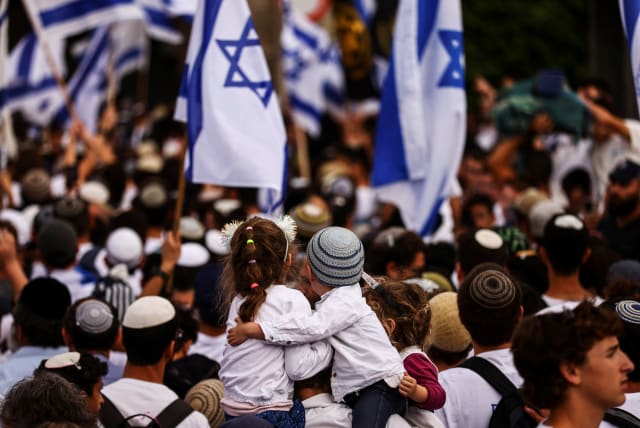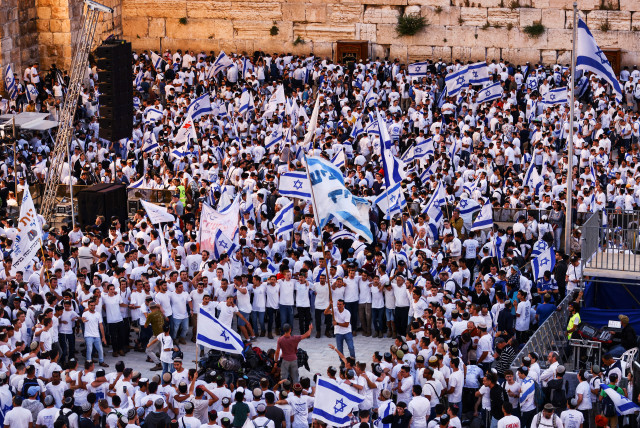United Jerusalem: The dream and the reality

NATIONAL AFFAIRS: The slogan “Don’t divide Jerusalem” still resonates loudly among the Israeli public.
In 1982, current Palestinian Authority President Mahmoud Abbas submitted a doctoral thesis to a Russian university titled, “Connection between the Nazis and the Leaders of the Zionist Movement 1933-1945.”
In that dissertation, later turned into a book, Abbas wrote that the Zionist movement and its leaders were “fundamental partners” with the Nazis and equally responsible for the Holocaust. He also wrote that the figure of six million Jews killed was exaggerated, and that the number of murdered Jews was closer to one million.
Some may argue that Abbas should not be called a Holocaust denier, since he did acknowledge one million Jews were killed. Instead, they would call him a Holocaust revisionist. Others, however, say that claiming the number of Jews murdered was far below the accepted figure of six million is also Holocaust denial.
So while there may be a debate about whether Abbas should be called a Holocaust denier – he has never unequivocally disassociated himself from his thesis – when it comes to Temple Mount denial, Abbas, as he showed the world during his speech at the UN on May 15 commemorating the “Nakba,” is all in.
Abbas clearly denied any Jewish connection to the Temple Mount, saying that Israel has been digging for 30 years on the site looking for proof of the existence of the temples there but “haven’t found anything.” Al-Haram al-Sharif, the Arabic name for the Temple Mount, belongs exclusively to the Muslims. Why? Because the Jews have no connection there.
On Thursday, thousands of Israelis begged to differ, marching in the annual Flag March to the Western Wall to – among other reasons – demonstrate Israel’s connection to the site and Israeli sovereignty over the city.
Fifty-six years after Israel won east Jerusalem and the Temple Mount in a fiercely fought battle that began when Jordan’s King Hussein entered the war and opened up a third front against Israel by shelling Jerusalem, many still feel the need to demonstrate that Israel is sovereign in the city by marching through the city’s streets and the Old City’s Muslim Quarter.
Some ask, why? Abbas’s speech provided the answer: to respond to all those denying any connection between the Jewish people and Jerusalem.
Holocaust denial, or revisionism, and Temple Mount denial are two sides of the same coin – an attempt to erase any need or right for a Jewish presence anywhere in this corner of the world.
If the Holocaust did not happen, or not at the scope commonly believed, there is no reason for a safe haven for Jews. And if there were no temples on the Temple Mount, then even if the Jews need a safe refuge, it need not be in Israel.
As Abbas also said on Monday when taking the British to task for issuing the Balfour Declaration in 1917, Britain – had it wanted to “get rid of the Jews” – could have given them “another island somewhere else.”
This is just one of the ways in which Jerusalem, Judaism’s most holy city and the third holiest city in Islam, epitomizes the Israeli-Arab conflict.
Why did Hamas fire rockets toward the capital on Jerusalem Day in 2021 and threaten to do the same this year? Because Jerusalem Day – and the annual Flag March with all its in-your-face demonstrativeness – is a tangible display of Jewish sovereignty in a city to which Abbas and others believe the Jews have no historic connection.
YERUSHALAYIM. AL-QUDS. Jerusalem. Fifty-six years ago, those three were combined into one – Yerushalayim, Israel’s eternal, undivided capital. But is it really? According to the Central Bureau of Statistics, Jerusalem’s population numbers 984,500 residents. Of this, some 386,000 (39.2%) are Arabs, and nearly 600,000 (60.8%) are Jews. Of the Jewish population, 285,500 (29%) are haredim.
Mostly, these populations live in separate neighborhoods and study in separate schools. While Arabs move freely in west Jerusalem, Jews – for the most part – are afraid to walk or make a wrong turn and end up in one of the Arab parts of the city.
It is a city packed full of the hopes, visions and aspirations of so many, for so long, that there is no way a flesh-and-blood place could live up to all the hype. It has been placed by so many for so long on such a high pedestal that it must inevitably disappoint. It is all too real, all too human, not the Jerusalem of the dreams and imagination. It is united and unified under Israeli sovereignty, but mostly in name only.
Jerusalem, in so many senses, is a microcosm of the country. So many of the conflicts the country faces are played out in the capital: Jew vs Arab, haredi vs secular, nationalist vs humanist.
What is interesting is that before the Six Day War, when the city was liberated, the city – for most Israelis and Jews – was an afterthought, at least on a practical, everyday level, though not on a spiritual plane.
The UN partition resolution in 1947 envisioned an international status for Jerusalem, and this caused only a mild reaction throughout the Jewish world. A hue and cry was not raised about having a Jewish state without Jewish sovereignty over Jerusalem. The idea of Jewish sovereignty outside Jerusalem was – apparently – consolation for the lack of sovereignty over the city itself.
It is also worth noting that Zionism’s founder Theodor Herzl did not fall in love with the city when he visited it in 1898, writing of its dirt, poverty, and residents’ obsession with the hereafter. Nor did the city work its magic on David Ben-Gurion when he arrived in 1906.
But whatever ambivalence to the city displayed by Jews to earthly Jerusalem, it was transformed into ardent devotion after the 1967 war. This ambivalence melted away when the paratroopers conquered the Old City and then commander of the 55th Paratroopers Brigade Mordechai “Motta” Gur uttered his famous words, “Har Habayit b’yadeinu” (the Temple Mount is in our hands).
The liberation of the Wall in 1967 did something profound; it stirred something deep inside the Jewish soul: a sense of enormous gratitude that this generation – of all the generations over the past two millennia – was the one to merit witnessing and being part of a return of Jewish sovereignty over the city.
The intervening 56 years have had an impact, and the difficult and complex reality in the city has somewhat tamped down the initial ardor for it. And, yes, there are some who would readily redivide the city. But they remain a distinct minority.
The slogan “Don’t divide Jerusalem” still resonates loudly among the Israeli public – so loudly that it led Prime Minister Benjamin Netanyahu to victory over Shimon Peres in 1996, and again over Tzipi Livni in 2009. Polls consistently show that most Israelis say it is important to retain a unified Jerusalem under Israeli sovereignty in any possible accord with the Palestinians.
For the first time, the Oslo process put Jerusalem on the table in negotiations, and there have been various plans since then in which dividing the city was discussed. Ehud Barak tried to do it in 2000 and was roundly voted out of office a few months later by Ariel Sharon, ending a very brief stint as prime minister.
Where, and what, is Jerusalem
When discussing united Jerusalem, the question becomes what constitutes Jerusalem? The polls mentioned above asking about the dividing of Jerusalem generally refer to the heart of Jerusalem: to the Old City and City of David. It is doubtful, however, that if you break it down further and ask about the Shuafat refugee camp and some of the outlying Arab villages, like Kafr Akab or Umm Tuba, the sentiment about never dividing the city would be the same.
Israelis are attached to parts of east Jerusalem taken in the Six Day War – the Old City, the Temple Mount, the Jewish Quarter, the Mount Of Olives and the City of David – but much less to places incorporated after the war, like Umm Tuba and the Shuafat refugee camp.
The late Ronnie Ellenblum, a professor of geography at the Hebrew University of Jerusalem, said several years ago that Jerusalem is “not just a city; it’s a symbol – an icon. Where does an icon end?” And that’s actually a very pertinent question. Over the last century, what has been defined as Jerusalem has grown enormously.
From the Bible until today: A history of Jerusalem
Biblical Jerusalem encompassed the Temple Mount and the City of David. During the First and Second Temple periods, the city grew, reaching its peak during the Second Temple Period under Herod Agrippa, Herod’s grandson.
Ottoman Jerusalem was the Old City and some neighborhoods outside. Immediately after the 1967 war, Israel annexed east Jerusalem and dramatically expanded the city’s limits. Overnight it went from an area of some 44 sq.km., including east Jerusalem then under Jordanian control, to 114 sq.km.
Interestingly, the Babylonian Talmud discusses the area of Jerusalem. In Tractate Bava Batra, there is a discussion of the size of Jerusalem, with Rabba quoting a certain elder as saying that the size of initial Jerusalem was three parasangs – or about 19 sq.km.
In addition, Jerusalem went from having six Palestinian villages inside its municipal boundaries before the Six Day War to 28 afterward. There were many reasons the municipal borders of Jerusalem were extended so significantly after the war.
The first reason was demographic and territorial: Israel wanted to be able to build in Jerusalem, but to do so, more area was needed – the Jewish neighborhoods of Ramot, Pisgat Ze’ev, Har Homa, Gilo, French Hill and others are on the lands that were annexed after 1967. The land was needed to build for Jews, but in the process, many Palestinians were also incorporated, with the percentage of Arabs in Jerusalem under Israeli control going from 1% in 1966 to 26% after the war in 1967 to just over 39% today.
There are today some 340,000 Arabs in eastern Jerusalem. Were it an independent city, it would by far be the largest Arab town in the country. (Nazareth, by comparison, is home to 80,000 Israeli-Arabs).
Strategic reasons were also involved in the decision to so drastically expand Jerusalem’s territory after the Six Day War: to include the mountain ridges surrounding the city inside the new borders, to protect it.
There was also a desire to take in areas once owned by Jews, such as Neveh Ya’acov, and to incorporate Atarot, where an old British airport was located.
Another historic decision at the time had to do with administration of the holy sites: Israel would have sovereignty, but administration would be in the hands of each religious group.
Those decisions – both to annex large areas to the city and to put administration of the holy sites in the hands of the respective religions – were made in the immediate aftermath of the Six Day War. They have reverberated, for good and for bad, down to this very day – 56 years later.
Jerusalem Post Store
`; document.getElementById("linkPremium").innerHTML = cont; var divWithLink = document.getElementById("premium-link"); if (divWithLink !== null && divWithLink !== 'undefined') { divWithLink.style.border = "solid 1px #cb0f3e"; divWithLink.style.textAlign = "center"; divWithLink.style.marginBottom = "15px"; divWithLink.style.marginTop = "15px"; divWithLink.style.width = "100%"; divWithLink.style.backgroundColor = "#122952"; divWithLink.style.color = "#ffffff"; divWithLink.style.lineHeight = "1.5"; } } (function (v, i) { });


